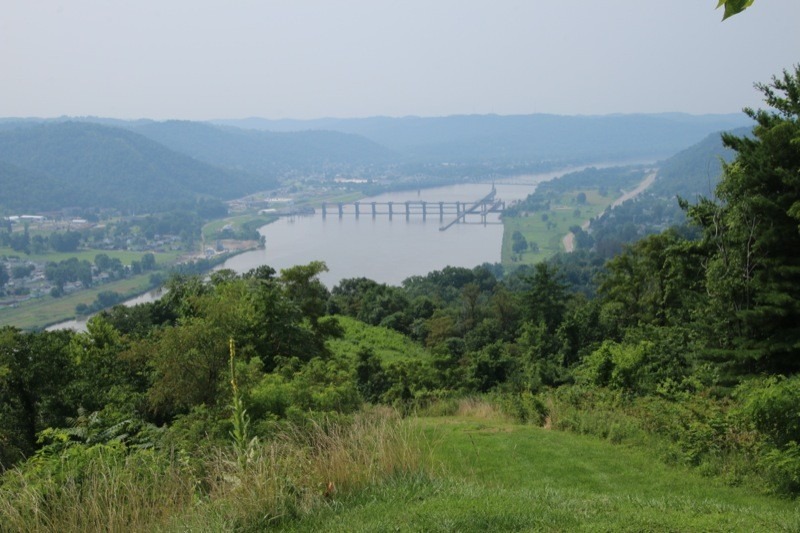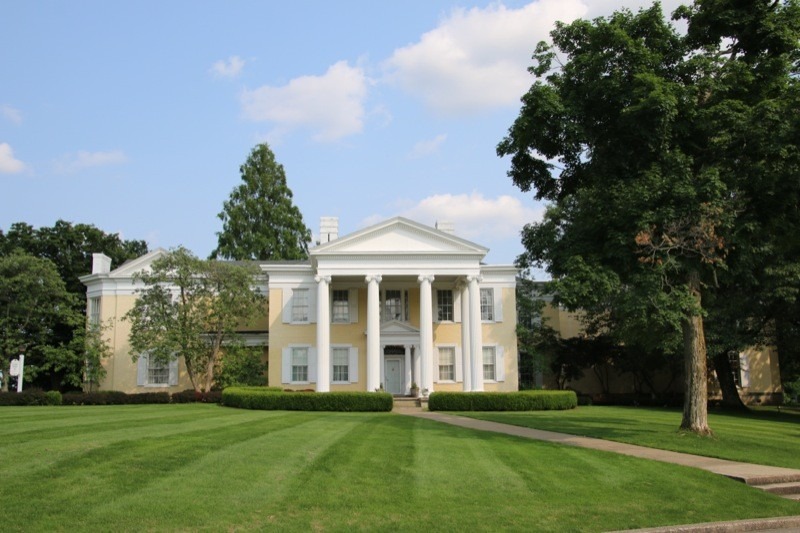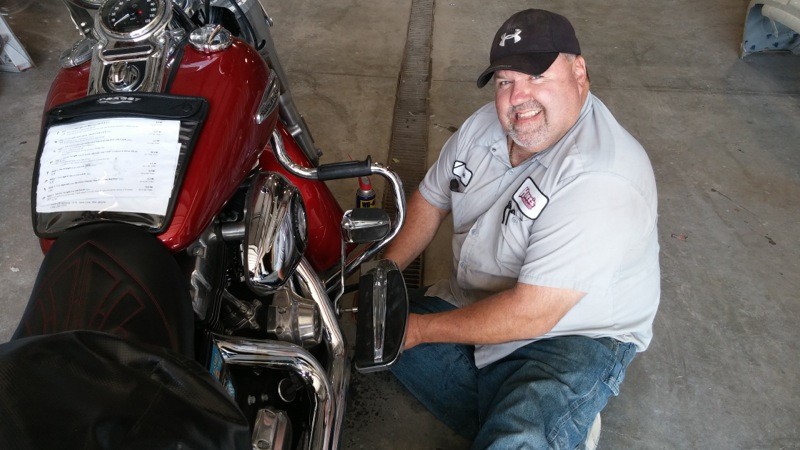West Virginia, July 3–14—“Wild and Wonderful” is one of the tourism slogans for West Virginia, and the state has put a lot of effort into attracting motorcycle riders. With 38,759 miles of public roads wholly contained within the Appalachian region, it’s a motorcyclist’s dream. So THUNDER PRESS contributor Thundercloud and I chose the Mountain State for our 2015 summer tour.

We both agreed that the most important elements of our adventure would be authentic folk music, good food, and, of course, great riding roads. We worked with West Virginia Division of Tourism’s Jane Bostic who called upon various regional Convention and Visitors Bureaus (CVBs) in the state to suggest routes and destinations, and with their help, we developed a 12-day riding tour.
Our West Virginia starting point was Wheeling, a city of about 28,000 people, and the Hampton Inn was our place of lodging for nights one and two. After a long day in the saddle, we were pleased to discover freshly-baked chocolate cookies at the front desk. And with covered parking, a swimming pool and two Jacuzzis, free breakfasts and attentive staff, the hotel proved to be a fine place to begin our tour. Plus the free shuttle service to local attractions was greatly appreciated; we didn’t want to ride to dinner in the rain one night, so our driver took us to a nearby restaurant, Ye Old Alpha, for a hearty, delicious meal.

The next morning we rode about 20 miles of curvy, rural roads, taking WV-88 and US-250 south to McCreary’s Ridge Road which led us to the Palace of Gold. This ornate structure, decorated inside and out with 22-carat gold leaf, was built by devotees of A.C. Bhaktivedanta Srila Prabhupada, founder of the International Society for Krishna Consciousness, also known as the Hare Krishna movement.
The Palace is located in the unincorporated village of New Vrindaban in the city of Moundsville, and also gracing the grounds are a Krishna temple, magnificent sculptures, a rose garden and a lotus pond. The road to the Palace is freshly paved, although the sloped gravel road that leads to visitor parking prompted us to leave our bikes on the blacktop next to the visitors’ center. That day, Snan Yatra, the “bathing festival,” was taking place; it was a colorful, fascinating ritual and we were fortunate to be there to observe it.
Although the onsite vegetarian restaurant was tempting our taste buds, we had other plans. We rode about 12 miles west from the Palace to see the West Virginia State Penitentiary in downtown Moundsville. The huge Gothic structure set on seven acres opened in 1876 and closed in 1995. Now the facility offers daily tours and special paranormal tours. It is said there are many ghosts there; not surprising, because while it was housing prisoners, the former penitentiary had been the scene of riots, escapes, murders, executions and general mayhem.

 Heading north on US-250/WV-2, we followed the Ohio River back up to Wheeling, and then rode north on WV-88 to Oglebay Resort. The beautiful 1,775-acre farm/country estate belonged to Earl W. Oglebay and in the 1920s was donated to the City of Wheeling. While we were looking for the Wilson Lodge, which offers over 270 guest rooms, we took an unintentional yet enjoyable riding tour of pretty much the entire estate, which features beautifully landscaped gardens, a 30-acre zoo and winter activities such as skiing and snowmobiling. Visitors can tour the mansion where Oglebay resided and also stay at the Wilson Lodge or one of the cottages and estate houses available to guests. The lodge offers a spa and restaurants—we ate lunch at the Glass Works Grill—and also onsite are specialty shops, an artisan center and glass museum.
Heading north on US-250/WV-2, we followed the Ohio River back up to Wheeling, and then rode north on WV-88 to Oglebay Resort. The beautiful 1,775-acre farm/country estate belonged to Earl W. Oglebay and in the 1920s was donated to the City of Wheeling. While we were looking for the Wilson Lodge, which offers over 270 guest rooms, we took an unintentional yet enjoyable riding tour of pretty much the entire estate, which features beautifully landscaped gardens, a 30-acre zoo and winter activities such as skiing and snowmobiling. Visitors can tour the mansion where Oglebay resided and also stay at the Wilson Lodge or one of the cottages and estate houses available to guests. The lodge offers a spa and restaurants—we ate lunch at the Glass Works Grill—and also onsite are specialty shops, an artisan center and glass museum.

That night, Wheeling celebrated the 4th of July with a Wheeling Symphony concert and fireworks show at Wheeling Heritage Port. The Wheeling Wharf is quite historically important, as Ohio River commerce in Wheeling was crucial to transporting people and products in the early 1800s. The Ohio River is very much still a “working” river; during the time we spent in the Ohio Valley we saw endless barges hauling coal and other cargo. And Wheeling was where we discovered the friendliness of West Virginians. The concert venue was like a country fair, with food and drink concessions and families spreading blankets or setting out chairs to enjoy the festivities. While we were trying to get photos of the performance, people moved over, asking if we needed more room, and then helped us find good vantage points. Here in New Jersey, people snarl, “Get outta my way. I was here first,” or the big fib, “I’m saving this spot.” West Virginians’ kind, welcoming demeanors were repeatedly demonstrated throughout our entire tour.

Jesse Mestrovic from the Greater Moundsville CVB had offered to lead us to our next destination, so Sunday morning, we left Wheeling for the 100-mile ride to Parkersburg. We followed Jesse down OH-7, the Ohio River Scenic Byway, from where we could see wonderful views of the Ohio River and WV-2 as it followed the West Virginia shoreline. Halfway through our ride, Jesse, on his Honda Hawk—and Thundercloud on her much bigger and heavier CVO Street Glide and me on my also-heavy Switchback—zipped along a series of small roads winding 3 ½ miles up the side of a mountain until we reached Kiedaisch Point Park. The summit revealed extraordinary views of the Ohio River, from north of the old Ormet plant, then south to the Hannibal Locks and Dam, the New Martinsville Bridge, New Martinsville itself and the mountains beyond.
We crossed the bridge back to WV-2 at St. Mary’s, and began to see American flags on every utility pole in every small town stand as silent escorts to our ride. In the few days since we arrived in West Virginia, we’d learned a lot more about the state, such as the story behind its break from then-Confederate Virginia to stay within the Union, and how important energy production is to the state’s economy. Although coal production has decreased over time, West Virginia is the largest producer of coal from underground mines, and in recent years, mining for oil and natural gas has increased. Coal is rarely used for home heating nowadays, with most of the reserves used to produce electricity, as evidenced by the power plants and their massive cooling towers we passed while riding through the Ohio Valley.

Mark Lewis of the Greater Parkersburg CVB had arranged to meet us at the famed Blennerhassett Hotel in Parkersburg where he’d arranged for Thundercloud and me to spend the night. The hotel was designed and built by successful businessman William Chancellor and its doors were opened to the public in 1889. It is registered as a National Historic Landmark and beautifully illustrates the architecture and décor of the “gaslight era.” The hotel offers every amenity we could think of, yet still maintains its wonderfully unique and historic character.
After a bounteous brunch at the hotel’s Spats Patio & Courtyard, we made our way just a few blocks over to the Blennerhassett Museum of Regional History to pick up tickets for the ferry ride to Blennerhassett Island State Park. In short order, Mark, Thundercloud and I boarded the Island Belle, a sternwheeler constructed in the 1800’s style. The ride to the island takes about 20 minutes, depending on river traffic. Upon disembarkation, we took a horse-drawn wagon tour of the island and also toured the Blennerhassett Mansion. The island has a fascinating history, involving wealthy Irish aristocrat Harman Blennerhassett and his wife Margaret who settled on the island in 1798 and there built a huge, opulent mansion. Unfortunately, they became enmeshed with Aaron Burr and the men were accused of treason in 1806. After Burr and Blennerhassett were acquitted, the Blennerhassetts fled the island, always meaning to return. However, in their absence, all the furnishings in the mansion were sold or given away, and the mansion mysteriously burned to the ground in 1811. In 1973, archaeologists discovered its foundation and eventually the mansion was recreated to serve as a museum. Many of the interior furnishings have been recovered and placed in the mansion, along with other pieces of the era. Just like many other historical attractions we visited in West Virginia, the mansion, in fact, the entire island, is said to be haunted.

That night, Steve and Patsy Hardy, proprietors of S&P Harley-Davidson in Williamstown, joined Mark, Thundercloud and I for dinner at Spats Restaurant & Lounge inside the hotel. After our meal, Steve and Patsy gave us a tour of their dealership in Williamstown, about 14 miles north of the hotel and just off I-77. The Hardys started in Marietta, Ohio, and then opened the doors of S&P in 2007. Both the exterior and interior designs exude warmth and welcome, much like Patsy and Steve themselves.
There were many more places we would have liked to have visited in Parkersburg but Monday morning we were back on the road. We took curvy, scenic US-50 east and US-19 south for about 100 miles until reaching Weston where the Trans Allegheny Lunatic Asylum awaited our visit. Built in the mid-1800’s as an asylum for the mentally ill, it was constructed in the Gothic Revival and Tudor Revival styles, and is the second-largest hand-cut sandstone building in the world, second only to the Kremlin.

As consultant on the architecture as well as patient treatments, Thomas Kirkbride, superintendent of the Pennsylvania Hospital for the Insane, oversaw furnishings and instilled philosophies that were astoundingly progressive and humane for those times. Over the years, the 242,000 sq. ft. hospital went through a series of changes—as Weston Hospital, it was designated a National Historic Landmark—and finally closed to patients in 1994. It sat idle, falling into various states of disrepair and was finally auctioned off by the West Virginia Department of Health and Human Resources in 2007. Joe Jordan, an asbestos demolition contractor from Morgantown, was the high bidder and paid $1.5 million for the building.
Renovations have been underway and the hospital is now open for tours, with ours given by Greg Hill, the asylum’s historic trainer/guide. It was a quite fascinating and highly intense experience—this is another place with plenty of paranormal activity—and we recommend it highly.
After the tour, we backtracked a few miles up WV-19 for lunch at the Hickory House Restaurant in Jane Lew where we enjoyed huge portions of their fabulous barbecue. I scarfed down a hickory wood-roasted chicken dinner with Mama Sue’s special sauce, and Thundercloud partook of a smoked beef brisket platter.

I was a little distracted during lunch, though. I’d started noticing that my rear brake seemed to be dragging. Today it was so bad I could smell it burning. I asked Tammy, our waitress, if there was anyone around who could help, and she suggested we take the bike to Hitt’s Auto Body just down the road and ask for Ink. She even called them to say we were coming. Ink immediately identified the problem: it was the rear brake pedal that was stuck! He took it apart, cleaned all the crud out of the bushing, put everything back together and it was good as new. Tammy and Ink were just two more fine examples of West Virginia hospitality and helpfulness.
The next leg of our journey took us east on US-33 and then north on US-219 through the wilderness of the Allegheny Mountains to the Canaan Valley Resort. The resort, which is also a state park, offers stunning views of the surrounding mountains and valleys. That night, Jessica Scowcroft of the Tucker County CVB took us to the Purple Fiddle a few miles away in Thomas where we availed ourselves of the fine deli fare and were blown away by performers Herb & Hanson’s original compositions rooted in regional folk and blues music. The Purple Fiddle was a general store that still retains its old-time characteristics, and this is where we discovered that we were on the Mountain Music Trail, which promotes traditional music and dance of the Allegheny Mountain region along Highway 219.

After a restful night, we rode 20 minutes on WV-32 north to Blackwater Falls State Park and stood awestruck on an observation platform, watching the amber-colored water pound giant rocks below and then continue along an eight-mile gorge. The falls were named for the dark-colored water; a result of tannic acid from fallen hemlock and red spruce needles. Retracing our route south a bit, we continued on West Virginia Routes 32 south and turned onto 33 east for about 30 miles until we reached Seneca Rocks, a popular motorcyclists’ waypoint. It’s been nearly 15 years since I was there last, but I remembered the delectable peach cobbler served upstairs at the Front Porch Restaurant. Thundercloud and I shared a serving and it was just as luscious as I recalled.

a powerful spiritual
experience for both
Thundercloud and me
We rode another 120 delightful miles south on WV-28 WV-92 toward Greenbrier County. This wasn’t the most technically challenging ride, but the gentle curves and ever-changing scenery, with the whole route taking us through the Allegheny Mountains and the Monongahela State Forest, made this our favorite ride of the entire journey. These roads, just as all the other West Virginia state and federal roads we traversed, were extremely well maintained, making the ride extremely enjoyable rather than nerve-, body- and bike-wracking. And West Virginia is a place of great variety, featuring mountain roads interspersed with forests that make up about three-quarters of the state, with most of the remainder comprising farmlands and rural towns (the state has only 14 cities with populations over 10,000).
In White Sulphur Springs, we turned east onto WV-60 and rode past The Greenbrier, a National Historic Landmark. The Greenbrier is a 10,000-acre luxury resort with every imaginable amenity and leisure activity available. We added that to our list of places to stay during our next visit. A few miles later we were in Ronceverte for our stay at the Edgarton Inn Bed & Breakfast. It was like taking a ride back through time. The Edgarton Inn is the oldest residence in town, and is a lovely example of Queen Anne-style architecture. Thomas Edgar, founder of the Ronceverte settlement, built the original dwelling around 1810 and it has been added onto in the years since then. Current owner Kathy King purchased the home in 2010, redecorated it and transformed it into a bed and breakfast. Although the Edgarton Inn was delightful, we weren’t enamored of the sloped, uneven brick-and-gravel drive up to the parking area in back, but we made it up and down again with no mishaps. Next time we might ask permission to park in the library lot across the street.

Later that evening, Kristy Godby of the Greenbrier County CVB escorted us to dinner at Food & Friends in nearby Lewisburg, self-described as the “coolest small town in America.” It is a lovely little town for sure. Afterwards she brought us to the American Heritage Music Hall, part of the Mountain Music Trail, back in Ronceverte. AHMH promotes live music and keeps alive the local musical heritage—country, old-time bluegrass, folk, and more. It was co-founded by Charlie Massie and Jeannie Crane. Jeannie passed away in 2013, but Charlie is still there running the place and sitting in on jam sessions. There was no way we could sit there quietly, unobserved. Folks stopped by our table, one at a time, then in pairs, then groups. We danced with old timers Clark and Ivan who tried to teach us the old-time flatfoot and the stroll. For authentic mountain music, this is the place. And the $7 admission includes coffee, soft drinks and homemade food brought by both patrons and musicians.
Wednesday morning, we departed for further West Virginia adventures. Watch for the second half of our tour in next month’s THUNDER PRESS.


Resources:
West Virginia Division of Tourism
Greater Moundsville Convention & Visitors Bureau
Palace of Gold
Greater Parkersburg Convention & Visitors Bureau
Blennerhassett Island State Park
blennerhassettislandstatepark.com
Blennerhassett Hotel
Trans-Allegheny Lunatic Asylum
trans-alleghenylunaticasylum.com
Hickory House Restaurant
Tucker County Convention & Visitors Bureau
Canaan Valley Resort & State Park
Mountain Music Trail
Purple Fiddle
Greenbrier County Convention & Visitors Bureau
Edgarton Inn Bed & Breakfast
American Heritage Music Hall


















We were pleased to have you in Wheeling. We hope you will return.
Thank you so much for the mention of our restaurant, the Ye Olde Alpha! We are happy you enjoyed your meal! Stop back and see us!